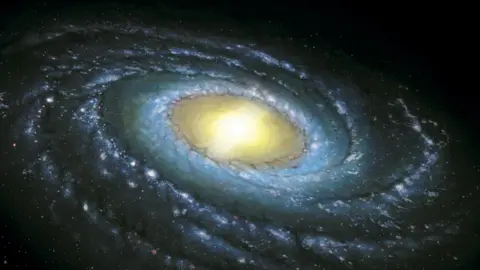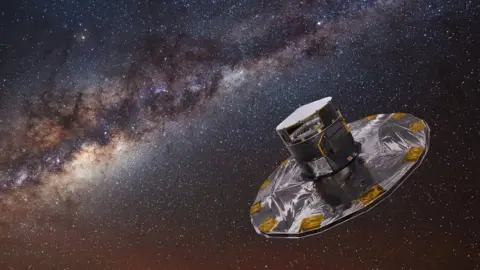Vast 'star nursery' region found in our galaxy
 Alyssa Goodman / Harvard University
Alyssa Goodman / Harvard UniversityAstronomers have discovered a vast structure in our galaxy, made up of many interconnected "nurseries" where stars are born.
The long, thin filament of gas is a whopping 9,000 light-years long and 400 light-years wide.
It lies around 500 light-years from our Sun, which is relatively close by in astronomical distances.
The discovery, outlined in the journal Nature, came from work to assemble a new map of the Milky Way.
An international team analysed data from the European Gaia space telescope, which was launched in 2013.
The monolithic structure has been dubbed the Radcliffe Wave, in honour of Harvard University's Radcliffe Institute for Advanced Study in Cambridge, Massachusetts.
"What we've observed is the largest coherent gas structure we know of in the galaxy, organized not in a ring but in a massive, undulating filament," said co-author Joao Alves, from the University of Vienna, Austria, and Harvard.
It is in the spiral arm (the long thin extensions of spiral galaxies that give them their name) located closest to our Solar System.
 SPL
SPLGaia was launched with the intention of precisely measuring the position, distance and motion of stars in our galaxy.
Team members used data from the European Space Agency telescope, along with other measurements, to construct a detailed, 3D map of interstellar matter in the Milky Way.
The results correct a previous view of this region of the Milky Way.
Many of the star-forming regions found in the Radcliffe Wave were previously thought to be part of a structure called Gould's Belt that was around 3,000 light-years (20 quadrillion km) wide.
Small, or far away?
First described in 1879, Gould's Belt was thought to be comprised of star-forming regions, believed to be oriented around the Sun in a ring.
The new study in Nature transforms that picture into one of a 90 quadrillion-kilometre-long, four quadrillion-kilometre-wide star-forming filament.
Co-author Prof Alyssa Goodman, from Harvard, commented: "We were completely shocked when we first realised how long and straight the Radcliffe Wave is, looking down on it from above in 3D."
 Esa
EsaShe added: "The wave's very existence is forcing us to rethink our understanding of the Milky Way's 3D structure."
All of the stars in the Universe, including our Sun, are formed when clouds of gas and dust undergo a gravitational collapse.
But working out how much mass the clouds have and how large they are has been difficult, because these things depend on how far away the clouds are.
Co-author Douglas Finkbeiner said: "Studying stellar births is complicated by imperfect data. We risk getting the details wrong, because if you're confused about distance, you're confused about size."
The results are being presented at the 235th meeting of the American Astronomical Society in Honolulu, Hawaii.
Follow Paul on Twitter.
